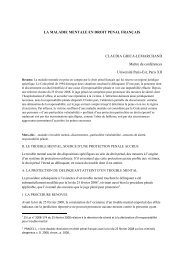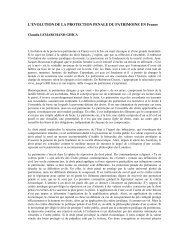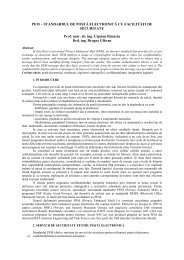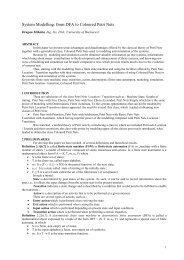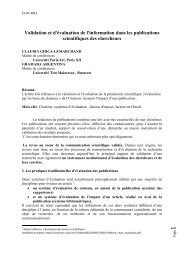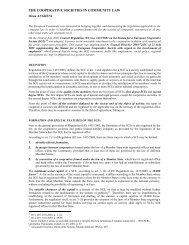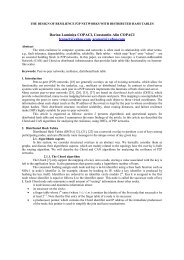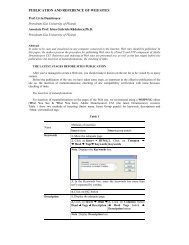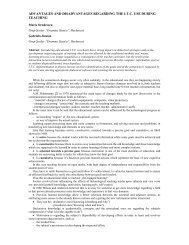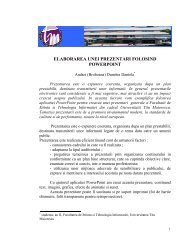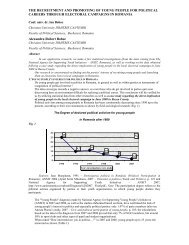Page 1 SOLVING SOME OPTIMIZATION PROBLEMS USING choco ...
Page 1 SOLVING SOME OPTIMIZATION PROBLEMS USING choco ...
Page 1 SOLVING SOME OPTIMIZATION PROBLEMS USING choco ...
You also want an ePaper? Increase the reach of your titles
YUMPU automatically turns print PDFs into web optimized ePapers that Google loves.
<strong>SOLVING</strong> <strong>SOME</strong> <strong>OPTIMIZATION</strong> <strong>PROBLEMS</strong> <strong>USING</strong> <strong>choco</strong> LIBRARY<br />
Lect. Radu Boriga, PhD candidate,<br />
Titu Maiorescu University, Bucharest<br />
<strong>choco</strong> is a Java library for constraint satisfaction problems, constraint programming and explanation -<br />
based constraint solving. It is built on an event-based propagation mechanism with backtrackable<br />
structures which is optimized using backjumping and backmarking techniques. In this article we present<br />
how to model some optimization problems by constraint satisfaction problems and how to solve them using<br />
<strong>choco</strong>.<br />
1. CONSTRAINT SATISFACTION PROBLEM (CSP)<br />
Although the works devoted to programming constraints have emerged since the 70s, the most clear<br />
definition of such programming was given by Eugene Freuder 1997: ” Constraint programming represents<br />
one of the closest approaches computer science has yet made to the Holy Grail of programming: the user<br />
states the problem, the computer solves it. ”<br />
A constraint is a logical relationship between several variables of a problem, each variable tak ing<br />
values in a given domain. It can be noted that, in general, constraints may specify partial information, are<br />
non-directional, are declarative, are additive and are rarely independent.<br />
From the properties listed above we can see that modeling a problem by using constraint programming<br />
lies in determining a finite number of variables with finite domeins and a finite set of constraints between<br />
them.<br />
Finding a solution for this problem consists in determining some acceptable values for each variable so<br />
as not to violate any constraint. Depending on the nature of the problem, solving it can mean to identify<br />
either a single solution or all solutions, or to identify an optimal solution, if it has been defined an objective<br />
function, too.<br />
Formally, a Constraint Satisfaction Problem (CSP) is defined ([1], [2]) by a triplet (X,D,C) such as:<br />
1. Variables: X x<br />
, x ,..., x is the set of variables of the problem.<br />
1 2 n<br />
2. Domain: D is a function which associates to each variable x i its domain D(x i ), i.e., the possible<br />
values that can be assigned to x i ( 1 i n)<br />
;<br />
3. Constraints: C c<br />
, c ,..., c is the set of constraints. Each constraint c<br />
1 2 n<br />
j is a relation between a<br />
subset of variables which restricts the domain of each one ( 1 j n)<br />
.<br />
We say that a constraint is satisfied if the tuple of the values of its variables belongs to the relation<br />
describing the constraint. Thus, solving a CSP consists in finding a tuple on the set of variables such that<br />
each constraint is satisfied.<br />
2. ABOUT <strong>choco</strong><br />
<strong>choco</strong> is an efficient constraint system for research and development and a readable constraint system<br />
for teaching ([4], [6]). It was started in 1999 within the OCRE project, a French national initiative for an<br />
open constraint solver for both teaching and research involving researchers and practitionners from Nantes<br />
(Ecole des Mines), Montpellier (LIRMM), Toulouse (INRA and ONERA) and Bouygues SA. Its first<br />
implementation was in CLAIRE ([6]). In 2003, <strong>choco</strong> went through its premiere major modification when<br />
it has been implemented into the Java programming language. The objective was to ensure a greater<br />
portability and an easier takeover for newcomers.<br />
In September 2008, when the second version was published, <strong>choco</strong> is being taken a step further: it<br />
offers a clear separation between the model and the solving machinery (providing both modelling tools and<br />
innovative solving tools), a complete refactoring improving its general performance, and a more<br />
userfriendly API for both newcomers and experienced CP practionne rs ([6],[5]).
As a problem modeler <strong>choco</strong> is able to manipulate a wide variety of variable types ( integer, set and<br />
real) and to accept over 70 constraints:<br />
all classical arithmetical constraints (equal, not equal, less or equal, greater or equal, etc.);<br />
boolean operations between constraints;<br />
table constraints defining the sets of tuples that (do not) verify the intended relation for a set of<br />
variables;<br />
a large set of useful classical global constraints including the alldifferent constraint, the<br />
global cardinality constraint, the nvalue constraint, the element constraint, the<br />
cumulative constraint;<br />
most recent implementations of global constraints, including the tree constraint and the geost<br />
constraint.<br />
As a solver <strong>choco</strong> provides several implementations of th e various domain types (enumerated,<br />
bounded, list-based and integer variables) and several algorithms for constraint propagation (algorithms for<br />
table constraints, full and bound alldifferent, parameterized cumulative, etc.). It can either be used in<br />
satisfaction mode (computing one solution, all solutions or iterating them) or in optimization mode<br />
(maximisation and minimisation). Search can be parameterized using a set of predefined variable and value<br />
selection heuristics.<br />
Finally, when converting the mod el into a solver-specific problem, <strong>choco</strong> can enter into a preprocessor<br />
mode that will perform some automatic improvements in the model.<br />
3. THE KNAPSACK PROBLEM<br />
3.1 The Binary Knapsack Problem<br />
Firstly, we review the terms of the Binary Knapsack Problem: “Considering a set of n items, for each<br />
item we have associated a profit p j and a weight w j ( 1 j n)<br />
. The objective is to pick some of the items,<br />
with maximal total profit, while obeying that the maximum total weight of the chosen items mus t not<br />
exceed the weight W which can be loaded in a knapsack . Moreover, any item can be fully charged or not at<br />
all.” Generally, the coefficients are scaled to become integers, and they are almost always assumed to be<br />
positive.<br />
Starting with the solution described in ([3]), it’s easy to model this problem by the next CSP:<br />
1. Variables: X x<br />
, x ,..., x <br />
1 2 n<br />
2. Domain: D( x i<br />
) {0,1}, i<br />
{1,2,...,<br />
n}<br />
3. Constraints: x w W<br />
n<br />
k<br />
k 1<br />
4. Goal: to maximize x p k k<br />
k<br />
n<br />
k1<br />
Based on the CSP above mentioned, we can model and solve the problem in a few steps using <strong>choco</strong>:<br />
1. creating a new model:<br />
Model m = new CPModel();<br />
2. creating the variables:<br />
IntegerVariable[] x = makeIntVarArray("x", n, 0, 1, "cp:enum");<br />
IntegerVariable c = makeIntVar("c", 1, 1000000, "cp:binary");<br />
3. creating the constraints:<br />
m.addConstraint(leq(scalar(w, x), W));<br />
m.addConstraint(eq(scalar(p, x), c));<br />
4. creating a new solver and loading the model into it:
Solver s = new CPSolver();<br />
s.read(m);<br />
5. solving the problem:<br />
s.maximize(s.getVar(c), false);<br />
6. printing all the solution:<br />
System.out.println("Maximum benefit: " + s.getVar(c).getVal());<br />
for (int i = 0; i < n; i++)<br />
System.out.println("Object " + (i + 1) + ": " +<br />
s.getVar(x[i]).getVal());<br />
3.2 The Bounded Knapsack Problem<br />
The Bounded Knapsack Problem specifies for each item j ( 1 j n)<br />
, additionally, an upper bound u j<br />
(which may be a positive integer) on the number of times item j can be selected.<br />
It’s easy to see that the only a minor difference appears when we are creating the variable s<br />
x 1 ,…,x n :<br />
IntegerVariable[] x = makeIntVarArray("x", n);<br />
for(int i=0;i
2. creating the variables:<br />
IntegerVariable[] x = makeIntVarArray("x", n);<br />
for(int i=0;i



